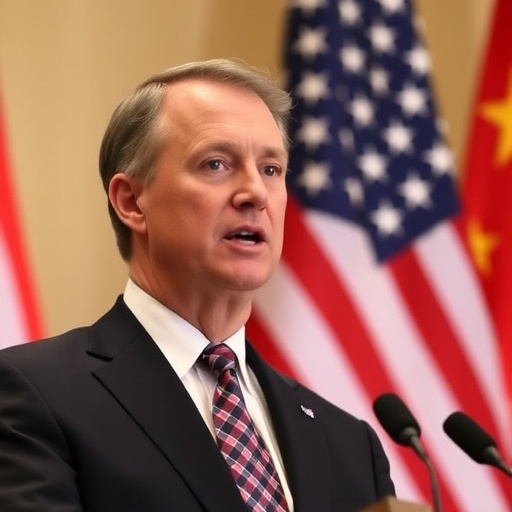In a stunning development that has sent ripples through global markets, Treasury Secretary Scott Bessent announced a groundbreaking framework agreement with China on Wednesday, effectively averting a fresh wave of threatened tariffs and securing key commitments on agriculture exports and the crackdown on fentanyl precursor chemicals. The deal, forged through intense trade talks, comes just weeks before a highly anticipated summit between President Donald Trump and Chinese President Xi Jinping, marking a potential turning point in the often fractious U.S.-China economic relationship.
Speaking at a press conference in Washington, D.C., Bessent hailed the agreement as ‘a pragmatic step forward that protects American workers, farmers, and communities ravaged by the opioid crisis.’ The announcement triggered an immediate surge in U.S. stock futures, with the Dow Jones Industrial Average climbing 1.2% in after-hours trading, reflecting investor relief over the de-escalation of trade tensions.
Framework Forged: Core Elements of the U.S.-China Trade Pact
The framework agreement, the result of months of behind-the-scenes negotiations led by Secretary Bessent, outlines several pivotal concessions from Beijing. At its heart is a mutual commitment to pause the implementation of new tariffs that had been looming since the Trump administration’s aggressive trade policies reignited earlier this year. Under the deal, the U.S. will hold off on imposing an additional 25% tariff on $300 billion worth of Chinese imports, including electronics and consumer goods, while China agrees to refrain from retaliatory duties on American automobiles and aircraft.
One of the most significant wins for the U.S. agriculture sector involves China’s pledge to increase purchases of American farm products by at least 20% over the next two years. This includes soybeans, corn, and pork—staples that have suffered from previous trade disputes. According to the U.S. Department of Agriculture, China’s 2018-2019 trade war tariffs led to a $27 billion loss in agricultural exports, devastating Midwest farmers. ‘This commitment isn’t just numbers on a page; it’s a lifeline for our rural economies,’ Bessent emphasized, quoting data from the USDA that shows soybean prices have fluctuated wildly due to uncertainty in trade talks.
Another cornerstone addresses the fentanyl crisis, with China vowing to tighten controls on the export of precursor chemicals used in the production of the deadly synthetic opioid. The U.S. Centers for Disease Control and Prevention reports that fentanyl-related deaths exceeded 70,000 in 2023 alone, with much of the supply chain tracing back to Chinese manufacturers. The agreement mandates enhanced regulatory oversight, joint task forces for monitoring shipments, and penalties for non-compliant firms. ‘We’ve been pushing for this for years, and today, China is stepping up as a partner in this fight,’ Bessent stated, crediting bipartisan pressure in Congress for amplifying U.S. leverage.
These provisions build on the Phase One trade deal signed in 2020 under the first Trump administration, which China has only partially fulfilled. Experts note that while the new framework lacks the binding enforcement mechanisms of a full treaty, it provides a ‘substantial roadmap’ for deeper cooperation.
Tariff Tensions Eased: Economic Relief for Businesses and Consumers
The threat of escalating tariffs has loomed large over the U.S. economy since President Trump’s return to the White House, with his administration signaling a ‘reciprocal trade’ approach to counter what it calls unfair Chinese practices. In March, Trump tweeted, ‘China must play fair, or face the consequences—tariffs will protect American jobs!’ This rhetoric had fueled fears of a repeat of the 2018 trade war, which the Peterson Institute for International Economics estimates cost U.S. consumers $51 billion annually in higher prices.
Secretary Bessent’s breakthrough averts this scenario, offering immediate economic breathing room. Wall Street analysts project that the pause on tariffs could add 0.5 percentage points to U.S. GDP growth in the coming quarters. For instance, apparel retailers like Gap Inc. and tech giants such as Apple, which rely heavily on Chinese supply chains, stand to benefit from stabilized costs. ‘This deal removes a massive overhang from our operations,’ said a spokesperson for the U.S. Chamber of Commerce, which has lobbied vigorously for de-escalation.
On the Chinese side, the agreement alleviates pressure on its export-driven economy, which faces domestic challenges like slowing growth and youth unemployment. Beijing’s state media portrayed the framework as a ‘win-win’ outcome, emphasizing how increased U.S. agricultural imports would support China’s food security amid global supply disruptions. Trade data from the U.S. Census Bureau shows that bilateral trade volume dipped to $575 billion in 2023 from a peak of $659 billion in 2021, underscoring the mutual stakes.
However, skeptics warn that without swift implementation, the relief could be short-lived. ‘Tariffs are a blunt tool, but they’ve forced China to the table before,’ noted economist Gary Hufbauer of the Peterson Institute. ‘The real test will be enforcement—Bessent’s team must monitor compliance closely.’
Agriculture Boost and Fentanyl Fight: Targeted Wins in the Deal
Diving deeper into the agreement’s specifics, the agriculture commitments represent a boon for Trump’s political base in farm states like Iowa and Illinois. China, the world’s largest importer of soybeans, had shifted purchases to Brazil during the last trade spat, costing U.S. farmers billions. The new pact includes a minimum purchase quota of 40 million metric tons of U.S. soybeans annually, alongside tariff reductions on U.S. beef and dairy products to zero by mid-2025.
‘Our farmers have endured enough uncertainty; this deal puts money back in their pockets,’ Bessent declared, invoking Trump’s campaign promises to champion rural America. The American Farm Bureau Federation estimates that fulfilling these commitments could generate $15 billion in additional revenue for U.S. exporters over the next year.
Equally critical is the fentanyl precursor provision, which builds on a 2019 agreement but adds teeth through technology-sharing and real-time data exchanges. The U.S. Drug Enforcement Administration (DEA) has identified over 25 precursor chemicals originating from China that fuel North American cartels. Under the framework, China will blacklist additional substances and allow U.S. inspectors greater access to manufacturing sites. Health Secretary Xavier Becerra praised the move, stating, ‘Every precursor stopped at the source saves lives— this is a humanitarian imperative.’
Statistics paint a grim picture of the stakes: The National Institute on Drug Abuse reports that fentanyl is now involved in 70% of U.S. overdose deaths, with economic costs exceeding $1 trillion annually. By addressing this head-on, the trade talks under Bessent’s guidance blend economic and public health priorities, showcasing a multifaceted U.S. strategy.
Path to the Trump-Xi Summit: Diplomatic Momentum Builds
As the world eyes the upcoming Trump-Xi summit scheduled for late April in Singapore, this framework agreement serves as a diplomatic icebreaker. President Trump, known for his deal-making flair, has teased the meeting as ‘the most important of my presidency,’ hinting at broader discussions on technology transfers, intellectual property theft, and even geopolitical flashpoints like Taiwan.
Secretary Bessent, a former hedge fund manager with deep ties to Trump’s inner circle, played a pivotal role in bridging divides. Appointed in January, Bessent has advocated for ‘smart tariffs’ over blanket measures, drawing on his experience navigating global markets. In trade talks, he reportedly held virtual sessions with Chinese Vice Premier He Lifeng, emphasizing mutual benefits amid a volatile global economy influenced by the Russia-Ukraine war and Middle East tensions.
International reactions have been cautiously optimistic. The European Union, which has its own trade frictions with China, welcomed the de-escalation, with Trade Commissioner Valdis Dombrovskis noting it could ‘stabilize supply chains for all.’ In Asia, Japan’s Nikkei index rose 0.8% on the news, as reduced U.S.-China tariffs often spill over to regional trade.
Yet, challenges remain. Labor unions like the AFL-CIO express concerns that the deal doesn’t go far enough on worker protections, while environmental groups call for green clauses in future pacts. As preparations for the summit intensify, Bessent’s announcement has undeniably shifted the narrative from confrontation to collaboration.
Global Markets React and Future Implications Unfold
The markets’ enthusiastic response underscores the high stakes of U.S.-China trade talks. Beyond the initial stock surge, commodity prices stabilized, with soybean futures jumping 3% on the Chicago Board of Trade. Analysts from Goldman Sachs forecast that a successful Trump-Xi summit could unlock $100 billion in pent-up trade flows, benefiting sectors from semiconductors to renewable energy.
Looking ahead, the framework sets the stage for Phase Two negotiations, potentially covering subsidies for state-owned enterprises and currency manipulation—issues Trump has long flagged. Bessent indicated that the administration aims to ‘build on this momentum’ with quarterly reviews to ensure compliance, possibly involving WTO oversight.
For American consumers, the averting of tariffs means lower prices on everyday goods; for businesses, it offers predictability in an era of supply chain disruptions. As Trump prepares to meet Xi, this breakthrough not only eases immediate pressures but also signals a willingness to engage constructively. ‘Trade isn’t zero-sum; it’s about shared prosperity,’ Bessent concluded, encapsulating the hopeful tone as the U.S. and China navigate their complex interdependence.
In the broader context, this development could influence global trade norms, encouraging other nations to pursue similar bilateral frameworks. With Bessent at the helm, the Trump administration appears poised to leverage this win into lasting economic security, though vigilance will be key to translating promises into progress.








